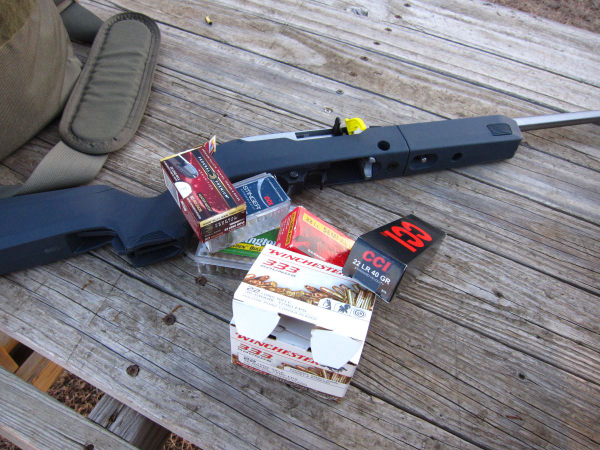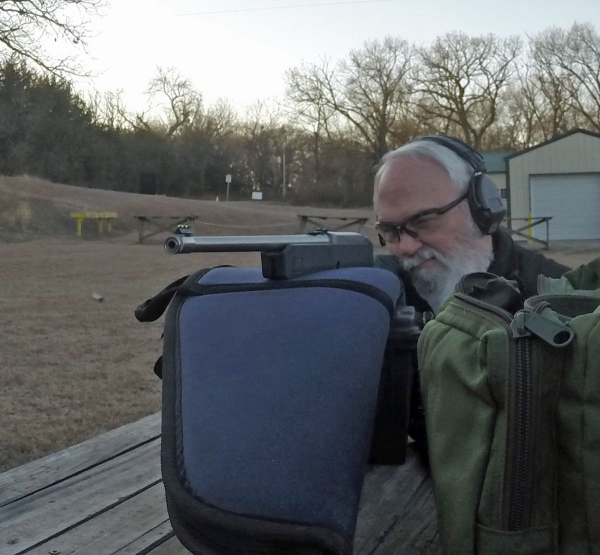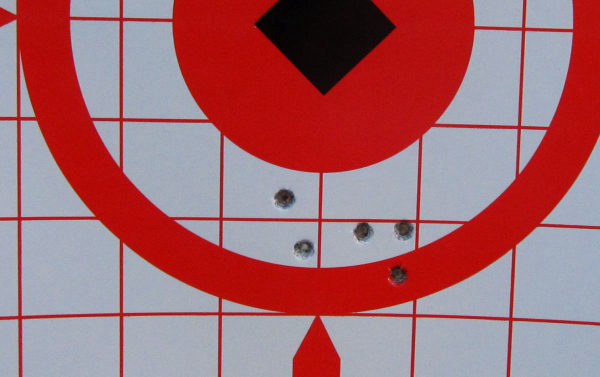
I got some shooting in with the Ruger 10/22 Takedown Backpacker – swapped for one that had conventional sights instead of the fiber optic sights – and found I was ‘on’ at fifty yards. That was reported here.
Thinking that getting closer, accounting for age-diminished vision, and getting a number of different rounds on paper would be helpful in determining (1) how far off the sights might be from point of impact and (2) which round(s) the gun preferred, I collected gear and went to the range early on a December morning.
While we had unseasonably warm weather, it usually got warm rather late in the day. I was unwilling to fight crowds, being somewhat compliant with the current government overreach – coincidentally avoiding virus exposure -- but having a range bay to myself was the big draw. The downside was the ca. 25°F temperature. And, being winter, it’s a little dim that early in the morning.
I wanted to get the work done with this fine rifle before the year’s end. My curiosity got me over the climate conditions.
The ammo I collected for this outing included the following:
Federal Hunter Match
Geco .22 l.r. SEMI-AUTO
Winchester “333” HP
CCI Stinger HP
CCI Standard Velocity
Remington Golden Bullet
Nearly all the loads were ‘high velocity.’ The exceptions were the very high velocity, light bullet Stingers and the CCI Standard Velocity, factory rated for only 1,070 FPS out of a rifle.
While the Ruger 10/22TD Backpacker is certainly a rifle, it’s shortish barrel -- 16.4” – isn’t the normal test-barrel length for ammo manufacturers. It’s, in my opinion, ideal for a light, handy field carbine.
The question was “will the standard velocity round work the semi-auto action?” It seems that some semi-auto 22s are sensitive to light recoiling, slow loads in the function department.

What I found is that, shooting from the bench, I was crowding the rear of the Magpul X-22 Backpacker stock to get low enough to see the sights. When shooting off-hand, it didn’t seem to be a problem. I figure it’s just me getting sorted out; I don’t have that issue with a more conventional stock.
I also found the 10/22 TD-BP is remarkably consistent across ammo brands/types in terms of accuracy. In fact, the rounds tended to fall under the sights at my “nonoptimal” 25-yard distance. I know the gun will shoot this well at fifty yards during decent weather – with a better bench rest, but the gun shot so consistently, I was surprised. The results follow:

|
Brand-type |
5-shot group |
Notes |
|
Geco .22 l.r. SEMI-AUTO 40gr. Solid |
1 ¼” |
3 into 3/8” |
|
Winchester “333” 36gr. HP |
2 5/8” |
3 into 1” |
|
CCI Stinger 32gr. HP |
2” |
4 into 1 ¼” |
|
CCI Standard Velocity 40gr. (1070fps) |
1 15/16” |
3 into 1” |
|
Remington Golden Bullet 36-grain |
1 ¼” |
3 into 7/8” |
|
Federal Hunter Match |
2 ½” |
1 ¼” without high flyer |
It should go without saying, but “you get what you pay for.” The Geco load shot the best, followed closely by – surprise – the Remington Golden Bullet load. And CCI Standard Velocity went into third place barely ahead of Stingers. The load fed, fired, extracted and ejected just fine from the TD-BP. CCI Stinger and Federal Hunter Match nearly tied – surprising me. Hunter Match is the go-to “accuracy load” for most 22s I’ve fired it out of, including Ruger’s GP100 10-shot revolver, the standard Ruger 10/22TD, their American Rimfire Compact, the S&W SW22 Victory and Kit Gun.
As to the Ruger 10/22 Takedown, Model 31152, with Stealth Gray Magpul X-22 Backpacker stock, fiber optic sights and with four 10-shot magazines included (three are in the stock), it seems the handiest, more portable and slickest version thus far of the 10/22 line. The fiber optic sights aren’t great for absolute precision, but they’re bright, easy to see and plenty precise enough to take care of any job you’re likely to encounter in the wild.
In fact, in the early morning gray, there was enough light to make those sights glow. I was impressed.
You can’t beat a rig like this. Take a look at the Ruger website to see this and some of their other fine offerings.
-- Rich Grassi